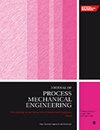Entropy optimization in ternary hybrid nanofluid flow over a convectively heated bidirectional stretching sheet with Lorentz forces and viscous dissipation: A Cattaneo–Christov heat flux model
IF 2.2
4区 工程技术
Q2 ENGINEERING, MECHANICAL
Proceedings of the Institution of Mechanical Engineers, Part E: Journal of Process Mechanical Engineering
Pub Date : 2024-08-26
DOI:10.1177/09544089241275779
引用次数: 0
Abstract
Bidirectional stretching sheet models can represent surfaces in heat exchangers where fluids flow under continuous deformation. Ternary hybrid nanofluids could be employed in these systems to increase heat transfer rates between fluids in heat exchangers and improve the efficiency of energy conversion processes. In this work, we explore the novel application of a ternary hybrid nanofluid (water with titanium dioxide, cobalt ferrite, and magnesium oxide nanoparticles) for enhanced heat transfer in heat exchangers modeled by a bidirectional stretching sheet. This approach offers a potential advancement over traditional nanofluids (with one or two nanoparticles). Furthermore, we present a comprehensive analysis that incorporates ohmic heating, Cattaneo–Christov heat flux, thermal radiation, viscous dissipation, and irreversibility. The governing equations are transformed into a system of nonlinear ordinary differential equations using appropriate similarity transformations and then solved using the bvp4c solver, a MATLAB built-in function. This study's findings reveal that the Eckert number and radiation parameter increase fluid temperature, while the thermal relaxation parameter leads to a reduction in the temperature of the fluid. It is detected that an increase in magnetic field parameter and volume fraction of [Formula: see text] results in a decline of the skin friction factors in both directions. It is revealed that there is a reduction in the Nusselt number with the rise in Eckert number ([Formula: see text]), and the same number declines at a rate of 0.8252 when [Formula: see text]. It is noticed that the skin friction coefficient declines at a rate of 0.62179204 (in case of x-direction) and 0.621791816 (in case of y-direction), respectively, when the values of magnetic field parameter lie between 0 and 3.5. Furthermore, it is noticed that an upsurge in thermal relaxation parameter results in a fall in the temperature of the fluid.具有洛伦兹力和粘性耗散的对流加热双向拉伸片上的三元混合纳米流体流动中的熵优化:卡塔尼奥-克里斯托夫热通量模型
双向拉伸片模型可以代表热交换器中流体在连续变形下流动的表面。在这些系统中可以使用三元混合纳米流体,以提高热交换器中流体之间的传热率,并提高能量转换过程的效率。在这项工作中,我们探索了三元混合纳米流体(水与二氧化钛、铁氧体钴和氧化镁纳米颗粒)的新应用,以增强双向拉伸片模型热交换器中的传热。与传统的纳米流体(只有一种或两种纳米颗粒)相比,这种方法具有潜在的优势。此外,我们还提出了一项综合分析,其中包括欧姆加热、卡塔尼奥-克里斯托夫热通量、热辐射、粘性耗散和不可逆性。利用适当的相似变换将治理方程转化为非线性常微分方程系统,然后使用 MATLAB 内置函数 bvp4c 求解器进行求解。研究结果表明,埃克特数和辐射参数会提高流体温度,而热松弛参数则会降低流体温度。研究发现,磁场参数和[公式:见正文]体积分数的增加会导致两个方向的表皮摩擦因数下降。结果表明,随着埃克特数([计算公式:见正文])的增加,努塞尔特数也随之降低,当[计算公式:见正文]时,努塞尔特数以 0.8252 的速率下降。我们注意到,当磁场参数值在 0 至 3.5 之间时,表皮摩擦系数分别以 0.62179204(x 方向)和 0.621791816(y 方向)的速率下降。此外,我们还注意到,热弛豫参数的上升会导致流体温度的下降。
本文章由计算机程序翻译,如有差异,请以英文原文为准。
求助全文
约1分钟内获得全文
求助全文
来源期刊
CiteScore
3.80
自引率
16.70%
发文量
370
审稿时长
6 months
期刊介绍:
The Journal of Process Mechanical Engineering publishes high-quality, peer-reviewed papers covering a broad area of mechanical engineering activities associated with the design and operation of process equipment.

 求助内容:
求助内容: 应助结果提醒方式:
应助结果提醒方式:


